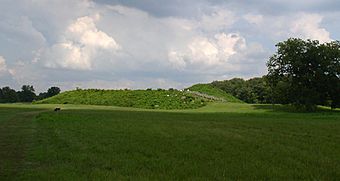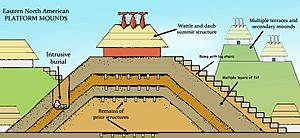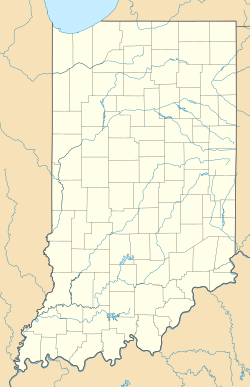Angel Mounds facts for kids
|
Angel Mounds
|
|

Mound A, Angel Mound Site, Evansville, Indiana.
|
|
| Nearest city | Evansville, IN Newburgh, IN |
|---|---|
| NRHP reference No. | 66000124 |
Quick facts for kids Significant dates |
|
| Added to NRHP | October 15, 1966 |
| Designated NHL | January 29, 1964 |
Angel Mounds State Historic Site is an amazing archaeological site in Indiana. It shows us what life was like for the Mississippian culture people long ago. This special place is managed by the Indiana State Museum and Historic Sites. It covers over 600 acres (about 240 hectares) of land. You can find it about 8 miles (13 km) southeast of Evansville.
This large community was built and lived in from about AD 1100 to AD 1450. It was a very important place, acting as the main center for a group of communities called the Angel chiefdom. This chiefdom stretched along the Ohio River valley for about 120 miles (190 km). At its busiest, the town had up to 1,000 people living inside its walls. It featured thirteen large earthen mounds, many homes, and a strong palisade (a tall wooden fence).
Angel Mounds was named a National Historic Landmark in 1964. Today, it has a visitor center and rebuilt Mississippian structures. There's even a copy of a 1939 archaeology lab from the Works Progress Administration. A large 500-acre (200-hectare) area away from the main dig site is a nature preserve. This historic site helps us learn about the ancient Mississippian people who lived along the Ohio River before Europeans arrived.
The site is named after the Angel family. They started buying the farmland where the site is located in 1852. In 1938, the Indiana Historical Society, with help from Eli Lilly, bought 480 acres (190 hectares). They wanted to protect the site and study it for a long time. From 1939 to 1942, the Works Progress Administration hired over 250 workers. They dug up a huge area, finding 2.3 million ancient items! After a break during World War II, work started again in 1945. Indiana University students helped with summer archaeology field schools. In 1946, the Indiana Historical Society gave the site to the State of Indiana. The Indiana State Museum now takes care of it.
Contents
A Look Back in Time
Ancient People and Their Culture
For thousands of years, different groups of native people lived in what is now the eastern United States. They often settled near rivers, using them for travel and trade. Around AD 900, a widespread group called the Mississippian culture developed. This culture is named after the Mississippi River valley where it began. It eventually spread across a huge area, from Oklahoma in the west to North Carolina in the east.
How Angel Mounds Grew and Changed
The Mississippian people built and lived in the Angel Mounds community. This was in what is now southwestern Indiana. They lived there from about AD 1100 to AD 1450. The site and its people are named after the Angel family. They bought the land in 1852.
The Angel chiefdom was a powerful trading center. It was led by a chief. This chiefdom included many smaller communities within 12 miles (19 km) of the Ohio River. It even reached the Green River in Kentucky. Angel Mounds was the main place for politics, culture, and trade. Its people traded with other groups along the Ohio and Mississippi rivers.
Workers started building the main Angel Mounds site after AD 1000. They also set up villages and farms along the Ohio River. The Mississippian people were famous for building large earthen mounds. These mounds came in different shapes, like flat-topped (platform), round, or long and narrow. They built thirteen mounds at Angel Mounds, some for ceremonies. The community grew to cover about 100 acres (40 hectares).
Besides the mounds, the Mississippians built homes and a strong defensive palisade. This fence was made of wattle and daub (sticks woven together and covered with mud). Its walls were 12 feet (3.7 m) high and had bastions (towers) for defense. Angel Mounds was the largest town of its kind in what is now Indiana. Experts think about 1,000 people lived there at its peak.
The Mississippian people left Angel Mounds long before Europeans arrived. We don't know exactly why they left. Some think it was because of environmental problems. A long drought might have reduced their corn crops. They might have also used up too many natural resources, like wood for building and fires. Archaeologists believe that many people moved downriver by AD 1450.
Later People and Discoveries
After the Mississippians left, other native groups like the Shawnee and Miami moved into the Ohio River valley. Later, European explorers and settlers arrived. They were all drawn to the rich soil and good farming weather. Mathias Angel, who lived from 1819 to 1899, was one of these settlers. He started buying the land in 1852. The Angel Mounds Historic Site is named after his family.
In 1931, important people like archaeologist Warren K. Moorehead and Eli Lilly visited the site. They wanted to see Indiana's ancient sites. Glenn A. Black, an archaeologist, thought Angel Mounds would be perfect for a long study. In 1938, the Indiana Historical Society bought 480 acres (190 hectares) of the land. They wanted to save it from being destroyed by new construction. Eli Lilly helped pay for the purchase.
Digging Up the Past
From 1939 to 1942, the Works Progress Administration (WPA) funded a big project. Over 250 workers, led by archaeologist Glenn A. Black, dug up a huge part of the site. They found 2.3 million ancient items! Work stopped during World War II. But it started again in 1945 with Indiana University students.
In 1946, the Indiana Historical Society gave the land to the State of Indiana. Glenn Black stayed on as caretaker. Later, new technology like a proton magnetometer was used to find hidden parts of the palisade walls. This was one of the first times such tools were used in the Americas.
Angel Mounds Today
Angel Mounds became a National Historic Landmark in 1964. The Indiana State Museum and Historic Sites now manages it. Research continues through the Glenn A. Black Laboratory of Archaeology at Indiana University Bloomington. This lab is named after Glenn Albert Black, who made the site famous.
Angel Mounds is one of the best-preserved ancient sites in the United States. It helps us understand the Mississippian culture along the Ohio River. The site has a visitor center, rebuilt Mississippian buildings, and a copy of the old WPA archaeology lab. There's also a large nature preserve with trails. Archaeological digs still happen here every summer.
The Site's Location
The Angel Mounds town was a trading hub for many smaller villages nearby. It sits overlooking the Ohio River to the south. The town was built on high land above the river's flood plain. It was protected from the river by an island. A quiet channel and slough (a swampy area) surrounded the town on three sides. These waterways were great for canoes, fishing, and getting fresh water.
The Mississippian people loved this spot along the Ohio River for farming. Each spring, floods brought new nutrients to the soil. This helped them grow lots of crops like maize (corn), beans, and squash. They grew so much food that they had extra. This allowed some people to become skilled artisans, making things like pottery.
Amazing Mounds
The site has six large platform mounds (Mounds A through F) and five smaller ones. A strong palisade with bastions almost completely surrounded the 100-acre (40-hectare) town. Mounds A, E, and F are the biggest. They are flat-topped, pyramid-shaped earthen structures. Mounds A and F were built around AD 1050 to 1100. They were used until the people left around AD 1400.
Mound A: The Central Mound
Mound A, also called the Central Mound, is the largest and tallest mound. It stands 44 feet (13 m) high. It's one of the biggest ancient structures in the eastern United States. Workers carried 67,785 cubic yards (51,820 cubic meters) of dirt in baskets to build it.
This mound likely served as the home for the main chief of the town. Important people usually lived on the highest mounds. Today, there's a modern stairway to protect the mound from people walking on it.
Mound F: The Temple Mound

Mound F was a platform mound, about 235 feet (72 m) by 239 feet (73 m) wide and 14 feet (4.3 m) tall. Digs showed it was built in several stages. Different structures were built on its various levels over time. The mound was taken apart during its excavation. Then, it was rebuilt to show how it looked originally. The rebuilt mound has a temple structure, a palisade, and stairs.
Mound E: The Third Largest Mound
Mound E is the third largest mound. It measures 160 feet (49 m) by 140 feet (43 m). Its top platform is 45 feet (14 m) by 40 feet (12 m). This mound was never farmed, so it's a great example of a flat-topped mound.
Strong Walls and Defenses
Archaeologists found two sets of palisade (stockade) walls. The outer wall went around the whole town, with the Ohio River protecting the south side. An inner wall divided the town. The main entrance was likely on the southwest side. Another barrier, like a picket fence, stood 14 feet (4.3 m) outside the main wall. This was to slow down attackers.
A part of the stockade was rebuilt in 1972. The reconstructed walls are 12 feet (3.7 m) high. They have wooden posts covered with wattle and daub (mud and grass plaster). Defensive bastions were also rebuilt. These towers were about 120 feet (37 m) apart. They stuck out 10 to 11 feet (3.0 to 3.4 m) from the wall. This spacing allowed defenders to protect the walls with arrows or spears.
Other Buildings and Structures
When homes became old, the Mississippians would burn them down. Then, they would build new ones over the ashes. Walls were likely covered in cane and plastered with mud and straw. The roofs were probably made of grass thatch. They used different building methods for summer and winter homes. Two round buildings found at the site might have been sweat lodges (like saunas) or meeting places. The Mississippians also built a public plaza between Mound A and Mound F.
Amazing Artifacts
Workers found about 2.4 million artifacts during the WPA digs from 1939 to 1942. One very important find was a carved stone statue of a seated man. It was found at Mound F in November 1940. This statue is 8.5 inches (22 cm) tall and weighs 11.5 pounds (5.2 kg). Similar rare statues have been found at other Mississippian sites.
Mississippian tools and weapons were made from different kinds of rock. Metal objects were very rare. People used bone fishhooks and nets to catch fish and shellfish. Spears were used to hunt small animals. They also found antlers, animal bones, shells, and teeth.
Nearly 2 million pieces of pottery were found. Some had unique painted designs. In 2006, researchers found what might have been a pottery-making workshop. This showed how skilled the Mississippian people were at art. Pottery tools and clay pieces were found there.
All the archaeological objects from Angel Mounds are kept and cared for at the IU Museum of Archaeology and Anthropology in Bloomington, Indiana.
Similar Sites: The Kincaid Focus
In the lower Ohio River valley, there are other Mississippian towns like Kincaid, Wickliffe, and Tolu. These sites, including Angel Mounds, are grouped together because they have similar pottery and town layouts. Kincaid and Angel Mounds are especially alike. This makes some experts think the same society built and lived in them.
Burial Sites
During the WPA digs (1939 to 1942), over 300 burials were found. Most were in the east village. Others were found near Mound F, Mound I, or the palisade walls. Sometimes, the remains of baby children were found under the floors of homes.
See also
- Angel phase
- Mississippian culture
- Caborn-Welborn culture
- Southeastern Ceremonial Complex
- Mississippian stone statuary
- List of Mississippian sites
- List of archaeological sites on the National Register of Historic Places in Indiana
- List of National Historic Landmarks in Indiana
- National Register of Historic Places listings in Vanderburgh County, Indiana
- National Register of Historic Places listings in Warrick County, Indiana









